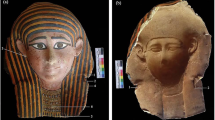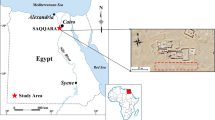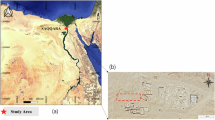Abstract
SINCE my communication published in NATURE of October 17, p. 460, an excellent example of an ancient Egyptian arch has come to hand in Plate 17 of Glanville's “Legacy of Egypt”1, a photographic print of an imitation of matting in faience and stone on a panel from a gallery in the Step Pyramid at Saqqara. On testing the upper are of this arch, I find that it is undoubtedly developed from a 5-unit circle in the way I suggested for the arch of the Saqqara graph.
This is a preview of subscription content, access via your institution
Access options
Subscribe to this journal
Receive 51 print issues and online access
$199.00 per year
only $3.90 per issue
Buy this article
- Purchase on SpringerLink
- Instant access to full article PDF
Prices may be subject to local taxes which are calculated during checkout
Similar content being viewed by others
References
"The Legacy of Egypt", edited by S. R. K. Glanville. (Clarendon Press, Oxford.) Plate 17 comes in Chap. 5, written by R. Engelbach.
Author information
Authors and Affiliations
Rights and permissions
About this article
Cite this article
WILLIAMSON, R. The Saqqara Graph. Nature 150, 607 (1942). https://doi.org/10.1038/150607b0
Issue date:
DOI: https://doi.org/10.1038/150607b0
This article is cited by
-
Mechanism of Bacterial Flocculation caused by Protozoa
Nature (1945)



